![]()
![]()
![]()
Use LEFT and RIGHT arrow keys to navigate between flashcards;
Use UP and DOWN arrow keys to flip the card;
H to show hint;
A reads text to speech;
25 Cards in this Set
- Front
- Back
|
Clupeiformes
|

Characteristics:
Silver scales, compressed keeled body, flexible mouth, thin gill rakers Planktivores |
|
|
Elopiformes
|
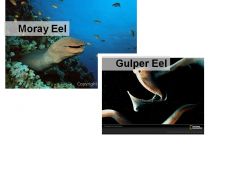
Characteristics:
Cycloid scales, gular plate, eel-like larvae |
|
|
Salmoniformes
|
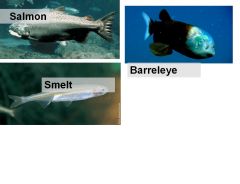
Characteristics:
Lack spines, fleshy adipose fin, abdominal pelvic fins, cycloid scales |
|
|
Stomiiformes
|
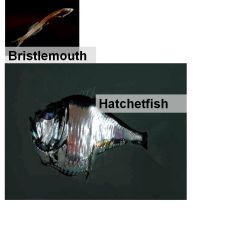
Characteristics:
Photophores, some adipose fins, black or silver, cycloid scales |
|
|
Aulopiformes
|
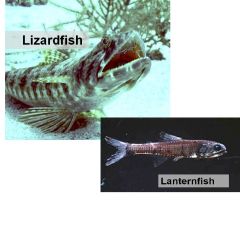
Characteristics:
Photophores, some adipose fins, black or silver, cycloid scales |
|
|
Gadiformes
|
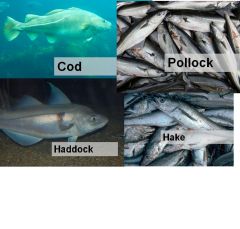
Characteristics:
Bottom dwellers, elongate bodies, tails taper to point, long dorsal and anal fins, pelvic fins thoracic or jugular, cycloid scales |
|
|
Batrachoidiformes
|
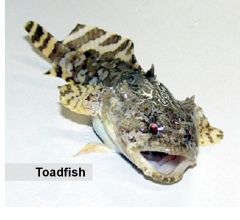
Characteristics:
Flat toad-like head, protruding dorsal eyes, large mouth, squat body, no scales, jugular pelvic fins, dorsal fin spine with venom |
|
|
Lophiformes
|
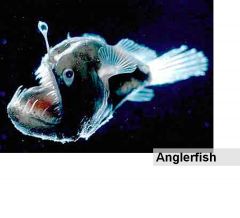
Characteristics:
Fishing lure on the head, large head, large mouth, cryptic color, small scales, small gills, jugular pelvic fins, no ribs |
|
|
Cyprinodontiformes
|

Characteristics:
Surface oriented body, large eyes, flattened heads, upturned mouth, dorsal fins far back on body |
|
|
Lampridiformes
|
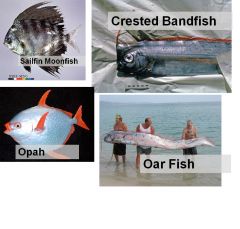
Characteristics:
Surface oriented body, large eyes, flattened heads, upturned mouth, dorsal fins far back on body |
|
|
Beryciformes
|
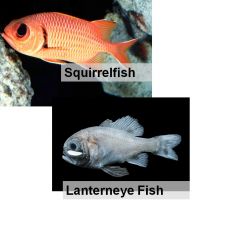
Characteristics:
Large eyes, red color (squirrelfishes), photophores (lanterneyes), conspicuous spines |
|
|
Zeiformes
|
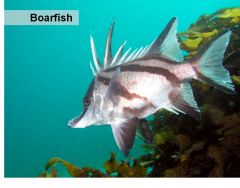
Characteristics:
Deep, compressed bodies, ctenoid scales, well developed fin spines, large head |
|
|
Gasterosteiformes
|
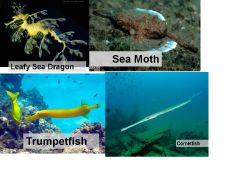
Characteristics:
Two major groups: sticklebacks and pipefish/seahorses Small fish, upturned mouth, narrow caudal peduncle |
|
|
Scorpaeniformes
|
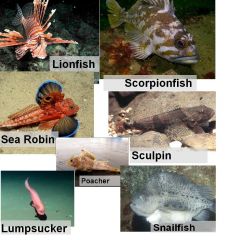
Characteristics:
Bottom oriented, round pectoral fins, large head, round caudal fin, spiny body and head |
|
|
Perciformes
|
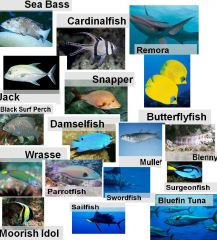
Characteristics:
Largest order of vertebrates Extremely diverse Fins spines, double dorsal fins, no adipose fin, pelvic fins thoracic or jugular, pelvic fins with one spine, pectoral fins with vertical insertion, ctenoid scales or none |
|
|
Pleuronectiformes
|
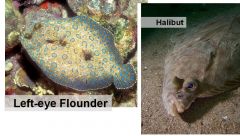
Characteristics:
No symmetry, flat, one side of body white and eyeless, one side dark with both eyes |
|
|
Tetradontiformes
|
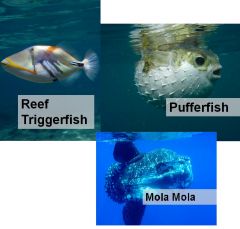
Characteristics:
Globular or triangular body shape, slow swimmers, propelled by fin waving, heavy protection (armor or inflation and spines), small gill openings |
|
|
Phocidae
|
True seals
|
|
|
Otariidae
|
Eared Seals
|
|
|
Odobenidae
|
Walruses
|
|
|
Mysticeti
|
Baleen Whales
|
|
|
Odontoceti
|
Toothed Whales
|
|
|
Procellariiformes
|
Albatross, Shearwater, Petrel, Fulmar
Tube-nosed seabirds Have tubular nostrils and a hooked bill Obtain food from the sea surface Plumage is dense and waterproof Dense coat of down Large salt glands Soaring wings, often very long |
|
|
Pelicaniformes
|
Pelicans, Cormorants, Tropicbird, Frigatebird, Booby, Gannet, Anhinga
Large, webbed feet All four toes joined by webbing Most have a distensible gular pouch Except the tropicbird Most have closed nostrils and breathe through mouth Except Pelicans and Tropicbirds |
|
|
Charadriiformes
|
Large group of waterbirds
18 Families, 300 spp Suborders: Charadrii: Wading Shorebirds Lari: Gulls, Terns, Skimmers, and Skuas Alcae: Auks, Murres and Puffins Sandpipers, Plovers, other shorebirds Feed by wading in shallow water along the shore Use bills to probe substrate for invertebrates or take from the water Long legs, long slender bills Hind toe usually well developed Cryptically colored |

